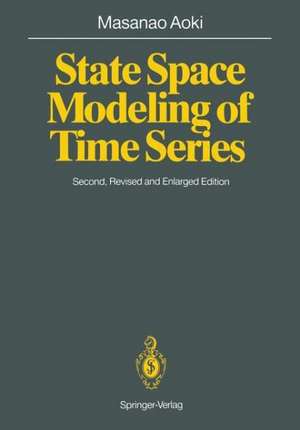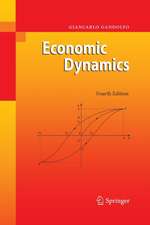State Space Modeling of Time Series: Universitext
Autor Masanao Aokien Limba Engleză Paperback – aug 1990
Din seria Universitext
- 13%
 Preț: 353.49 lei
Preț: 353.49 lei -
 Preț: 487.96 lei
Preț: 487.96 lei - 15%
 Preț: 543.75 lei
Preț: 543.75 lei -
 Preț: 418.67 lei
Preț: 418.67 lei - 20%
 Preț: 628.22 lei
Preț: 628.22 lei -
 Preț: 322.62 lei
Preț: 322.62 lei - 17%
 Preț: 364.82 lei
Preț: 364.82 lei -
 Preț: 634.38 lei
Preț: 634.38 lei - 17%
 Preț: 427.32 lei
Preț: 427.32 lei - 13%
 Preț: 355.52 lei
Preț: 355.52 lei - 17%
 Preț: 431.50 lei
Preț: 431.50 lei - 19%
 Preț: 429.21 lei
Preț: 429.21 lei - 19%
 Preț: 393.81 lei
Preț: 393.81 lei -
 Preț: 360.08 lei
Preț: 360.08 lei -
 Preț: 358.44 lei
Preț: 358.44 lei - 13%
 Preț: 389.95 lei
Preț: 389.95 lei -
 Preț: 465.61 lei
Preț: 465.61 lei -
 Preț: 371.99 lei
Preț: 371.99 lei - 15%
 Preț: 497.22 lei
Preț: 497.22 lei - 15%
 Preț: 737.46 lei
Preț: 737.46 lei - 17%
 Preț: 394.41 lei
Preț: 394.41 lei - 15%
 Preț: 509.58 lei
Preț: 509.58 lei - 17%
 Preț: 427.68 lei
Preț: 427.68 lei - 8%
 Preț: 495.44 lei
Preț: 495.44 lei - 17%
 Preț: 364.57 lei
Preț: 364.57 lei - 17%
 Preț: 368.15 lei
Preț: 368.15 lei -
 Preț: 396.55 lei
Preț: 396.55 lei - 15%
 Preț: 553.33 lei
Preț: 553.33 lei - 17%
 Preț: 365.35 lei
Preț: 365.35 lei -
 Preț: 356.78 lei
Preț: 356.78 lei -
 Preț: 673.45 lei
Preț: 673.45 lei - 17%
 Preț: 426.76 lei
Preț: 426.76 lei - 20%
 Preț: 569.56 lei
Preț: 569.56 lei -
 Preț: 372.87 lei
Preț: 372.87 lei -
 Preț: 319.07 lei
Preț: 319.07 lei -
 Preț: 379.86 lei
Preț: 379.86 lei -
 Preț: 445.88 lei
Preț: 445.88 lei -
 Preț: 382.36 lei
Preț: 382.36 lei - 15%
 Preț: 533.72 lei
Preț: 533.72 lei - 15%
 Preț: 496.02 lei
Preț: 496.02 lei - 15%
 Preț: 474.82 lei
Preț: 474.82 lei -
 Preț: 389.70 lei
Preț: 389.70 lei -
 Preț: 484.08 lei
Preț: 484.08 lei - 15%
 Preț: 643.48 lei
Preț: 643.48 lei -
 Preț: 415.02 lei
Preț: 415.02 lei - 15%
 Preț: 602.25 lei
Preț: 602.25 lei - 20%
 Preț: 510.24 lei
Preț: 510.24 lei - 15%
 Preț: 588.37 lei
Preț: 588.37 lei -
 Preț: 381.59 lei
Preț: 381.59 lei
Preț: 394.12 lei
Nou
Puncte Express: 591
Preț estimativ în valută:
75.42€ • 80.64$ • 62.88£
75.42€ • 80.64$ • 62.88£
Carte tipărită la comandă
Livrare economică 18 aprilie-02 mai
Preluare comenzi: 021 569.72.76
Specificații
ISBN-13: 9783540528708
ISBN-10: 3540528709
Pagini: 348
Ilustrații: XVII, 323 p. 3 illus.
Dimensiuni: 170 x 242 x 18 mm
Greutate: 0.56 kg
Ediția:Softcover reprint of the original 2nd ed. 1990
Editura: Springer Berlin, Heidelberg
Colecția Springer
Seria Universitext
Locul publicării:Berlin, Heidelberg, Germany
ISBN-10: 3540528709
Pagini: 348
Ilustrații: XVII, 323 p. 3 illus.
Dimensiuni: 170 x 242 x 18 mm
Greutate: 0.56 kg
Ediția:Softcover reprint of the original 2nd ed. 1990
Editura: Springer Berlin, Heidelberg
Colecția Springer
Seria Universitext
Locul publicării:Berlin, Heidelberg, Germany
Public țintă
GraduateCuprins
1. Introduction.- 2. The Notion of State.- 3. Data Generating Processes.- 3.1 Statistical Data Descriptions.- 3.2 Spectral Factorization.- 3.3 Decomposition of Time Series.- 3.4 Minimum-Phase Transfer Function Representation.- 4. State Space and ARMA Models.- 4.1 State Space Models.- 4.2 Conversion to State Space Representation.- 4.3 Conversion of State Space Models into ARMA Models.- 5. Properties of State Space Models.- 5.1 Observability.- 5.2 Orthogonal Projections.- 6. Hankel Matrix and Singular Value Decomposition.- 6.1 The Hankel Matrix.- 6.2 Singular Value Decomposition.- 6.3 Balanced Realization of State Space Model.- 6.4 Examples with Exact Covariance Matrices.- 6.5 Hankel Norm of a Transfer Function.- 6.6 Singular Value Decomposition in the z-Domain.- 7. Innovation Models, Riccati Equations, and Multiplier Analysis.- 7.1 Innovation Models.- 7.2 Solving Riccati Equations.- 7.3 Likelihood Functions.- 7.4 Dynamic Multiplier Analysis and Structural Model Identification.- 7.5 Out-of-Sample Forecasts.- 8. State Vectors and Optimality Measures.- 8.1 Canonical Variates.- 8.2 Prediction Error.- 8.3 Singular Values and Canonical Correlation Coefficients.- 9. Estimation of System Matrices.- 9.1 Two Classes of Estimators of System Matrices.- 9.2 Properties of Balanced Models.- 9.3 Examples with Exact Covariance Matrices.- 9.4 Numerical Examples.- 9.5 Monte Carlo Experiments.- 9.6 Model Selection.- 9.7 Incorporating Exogenous Variables.- 10. Approximate Models and Error Analysis.- 10.1 Structural Sensitivity.- 10.2 Error Norms.- 10.3 Asymptotic Error Covariance Matrices of Estimators.- 10.4 Other Statistical Aspects.- 11. Integrated Time Series.- 11.1 The Beveridge and Nelson Decomposition.- 11.2 State Space Decomposition.- 11.3 Contents of Random Walk Components.- 11.4 Cointegration, Error Correction, and Dynamic Aggregation.- 11.5 Two-Step Modeling Procedure.- 11.6 Dynamic Structure of Seasonal Components.- 11.7 Large Sample Properties.- 11.8 Drifts or Linear Deterministic Trends?.- 11.9 Regime Shifts.- 11.10 Nearly Integrated Processes.- 12. Numerical Examples.- 12.1 West Germany.- 12.2 United Kingdom.- 12.3 The United States of America.- 12.4 The US and West German Real GNP Interaction.- 12.5 The US and West German Real GNP and Unemployment Rate.- 12.6 The US and Japan Real GNP Interaction.- 12.7 The USA, West Germany, and Japan Real GNP Interaction.- 12.8 Further Examples.- Appendices.- A.1 Geometry of Weakly Stationary Stochastic Sequences.- A.2 The z-Transform.- A.3 Discrete and Continuous Time System Correspondences.- A.4 Some Useful Relations for Matrix Quadratic Forms.- A.5 Computation of Sample Covariance Matrices.- A.6 Properties of Symplectic Matrices.- A.7 Common Factors in ARMA Models.- A.8 Singular Value Decomposition Theorem.- A.9 Hankel Matrices.- A. 10 Spectral Factorization.- A.11 Time Series from Intertemporal Optimization.- A. 12 Time Series from Rational Expectations Models.- A. 13 Data Sources.- References.

















